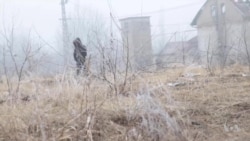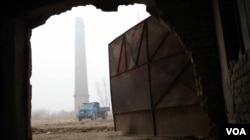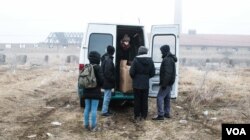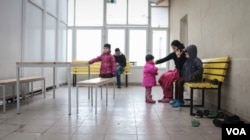It was his eighth failed attempt at getting into the European Union and Tahir claims that, just like half of his previous efforts, it ended in violence.
Tahir, who requested his entire name not be disclosed to protect his identity, is from Pakistan. He is among an estimated few hundred migrants and refugees camped out in scattered locations on the Serbian border with Hungary.
Unwilling to play the waiting game at the 17 official camps scattered across Serbia, he and others are trying to make their way across the heavily guarded fence.
“We were walking in Hungary for 12 hours, near to a motorway,” he told VOA from his current home, the crumbing remains of what was once a brick factory on the Serbian side of the border.
“But they must have traced us and when they caught us, they gave us a harsh punishment — they beat us," he said.”
Tahir’s account is impossible to verify, but as Hungary takes ever more strident measures to keep refugees from crossing illegally, concerns are mounting that violent and degrading treatment is increasingly being meted out to those who take their chances.
Beaten with batons
A volunteer organization named Fresh Response, which provides water, clothing and other necessities to refugees living along the Serbian border, has been collecting testimony from refugees and migrants, who say they experienced mistreatment before being returned to Serbia.
“What we know from reading the testimonies is that phases of abuse include pepper spray into the eyes, dogs being released on people — they’re muzzled, so using their claws — and people being beaten with batons,” Dan Song, of Fresh Response, said.
“In other testimonies people claim they have been forced to remove their clothes and lay down in the snow for 20 or 30 minutes,” Song added.
He said the alleged violence was not new. After a drop during autumn, incidents of alleged abuse were seen rising again, he added.
Song estimated that refugees and migrants now caught illegally trying to cross the border faced a 50 percent chance of experiencing similar treatment if caught on the Hungarian side of the border.
Other groups have documented such incidents, too, while violence is also thought to be commonplace along the Bulgarian and Croatian border.
A report titled Pushed Back at the Door, released last month by nongovernmental organizations from five eastern European EU member states, looked at the methods used to repel migrants and refugees.
The report claimed legalization last year in Hungary legitimizing "push-backs," which allow refugees caught within 8 kilometers of the border to be returned to the country they had just left, contravened EU obligations to those seeking protection.
Furthermore, it called the “widespread nature of reports on violence” inflicted on refugees trying to get into Hungry, as well as Bulgaria, a “serious concern.”
Slim chances
Meanwhile, the chances of crossing legally continue to decrease.
There are about 7,500 refugees and migrants in Serbia, and roughly 6,000 places in the country’s official camps.
Nearly everyone wants to move on to either Croatia or Hungary; as EU nations, the countries are seen as a gateway to western EU countries like Germany.
Yet with the Hungarian border recently reducing the number of refugees and migrants allowed through daily down to 10, many are eschewing a formal process that by some estimates now may take years rather than months — and not even allow them to cross once they have waited.
“There is a lack of trust towards going into camps,” said Andrea Contenta of Medicins San Frontieres [Doctors Without Borders], before adding that many also feared being expelled from Serbia once they had entered camps.
“The whole system is jammed,” Contenta said.
Facing that reality, many take their chances with smugglers or by going it alone into Hungary, where the reception seems ever more hostile.
Protecting the borders
“If we want Europe to stay the way as we know it, we must protect its outer borders, including the sea borders — with military forces, if needed,” Laszlo Toroczkai, the mayor of Assothalom, a Hungarian village near the border with Serbia that has reportedly sought to ban public practice of the Muslim faith, as well as “homosexual propaganda.”
Hungary completed the erection of a barbed-wire fence separating it from Serbia in September 2015, and, since then, has ramped up efforts to keep refugees and migrants out, including the ongoing effort to recruit 3,000 so-called "border hunters."
Toroczkai has been one step ahead of his own, strongly anti-refugee government. He set up the village’s five-person patrol team in early 2014, which works alongside national and international authorities patrolling the border.
But when it comes to charges of disproportionate use of force — something he says he only “hears about from journalists” — Toroczkai is adamant.
Emphasizing that people are crossing illegally, he says force is only used as a response to provocation.
“If one behaves violently and doesn’t obey the police order, doesn’t stop when he’s instructed to, and assaults the police officers, in the U.S. he would probably be shot," Toroczkai said. “Here in Hungary the worst thing that can happen to him is getting sprayed with tear gas or having dogs set on them."
Unprovoked
A former computer sciences student, Tahir claims he did nothing to provoke a beating.
As a relief from the harshness of his surroundings, Tahir scrolls through pictures of his home — Swat, the mountainous Pakistani district once controlled by the Taliban.
After three months living near the border, though, there are only so many times he is willing to endure these conditions, and risk more violence.
“This is not a life I have here. I feel like no one can help us,” Tahir said. “I feel hopeless.”















